I recently had the opportunity to examine a very early model 1894 Bergmann pistol, and made an interesting discovery (discovery to me, at any rate). The gun has a rather elegant bird’s-head grip, and a trigger that pulls as much down as it does back – the direction of the trigger pull is basically along the centerline of the grip. Well, when I went to take a sight picture, I put the pistol into a typical modern grip – hand high on the backstrap and arm extended straight. Which totally did not work. The distance to the trigger was too short to be comfortable, and my trigger finger was barely acting on the actual moving part of the trigger at all.
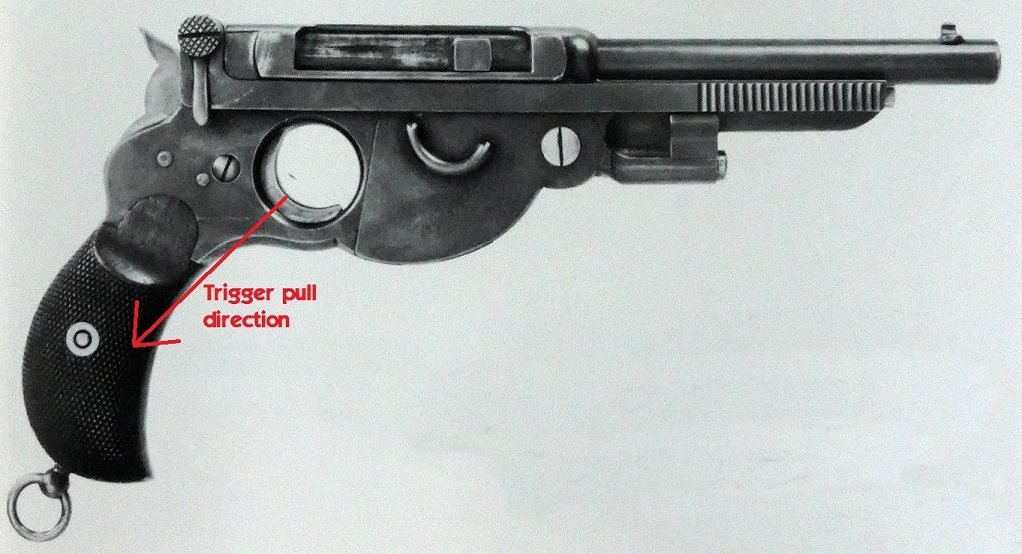
I though about this for a minute, and then recalled the picture postcards I have seen from German pistol shooting competitions around this period. The shooters are not-infrequently show with a quite different grip; one we would consider laughable today. It’s a one-handed stance (of course; all competitive pistol shooting was done one-handed), and the arm is bent at the elbow, with the wrist cocked down to bring the sights in line with the eye. The best example I can find on short notice is this, from Mötz & Schuy’s fantastic book Vom Ursprung Der Selbstladepistole:
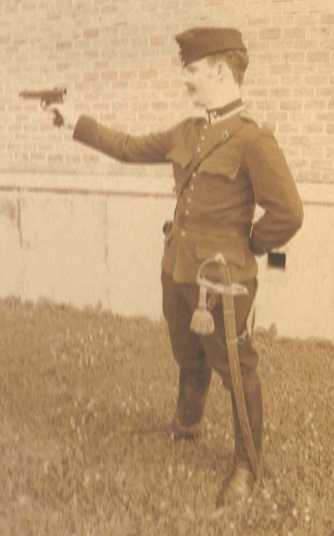
That fellow is using a somewhat subtler version of this stance than others I’ve seen, but it’s enough to get the idea across. And here the thing – when I shifted to using that type of grip on the 1894 Bergmann, everything came together. The birdshead grip now works well and makes sense, and my trigger finger comes to rest in the bottom curve of the trigger, in the right alignment to make a nice smooth press. Still a substandard target shooting grip in the overall scheme of things, but it seems clear to me that Bergmann designed the pistol with it specifically in mind. It does at least have the side benefit of bring the rather small sights a bit closer to the eye.
Sometimes there is no substitute to actually putting hands on a gun to understand it.

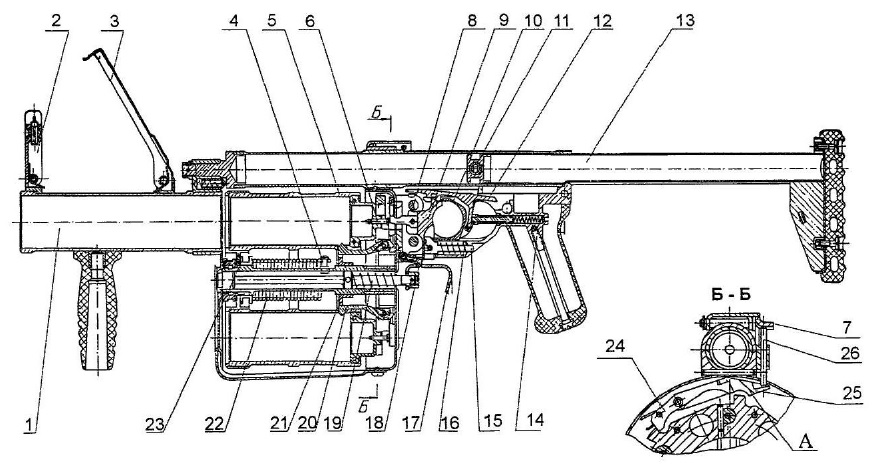
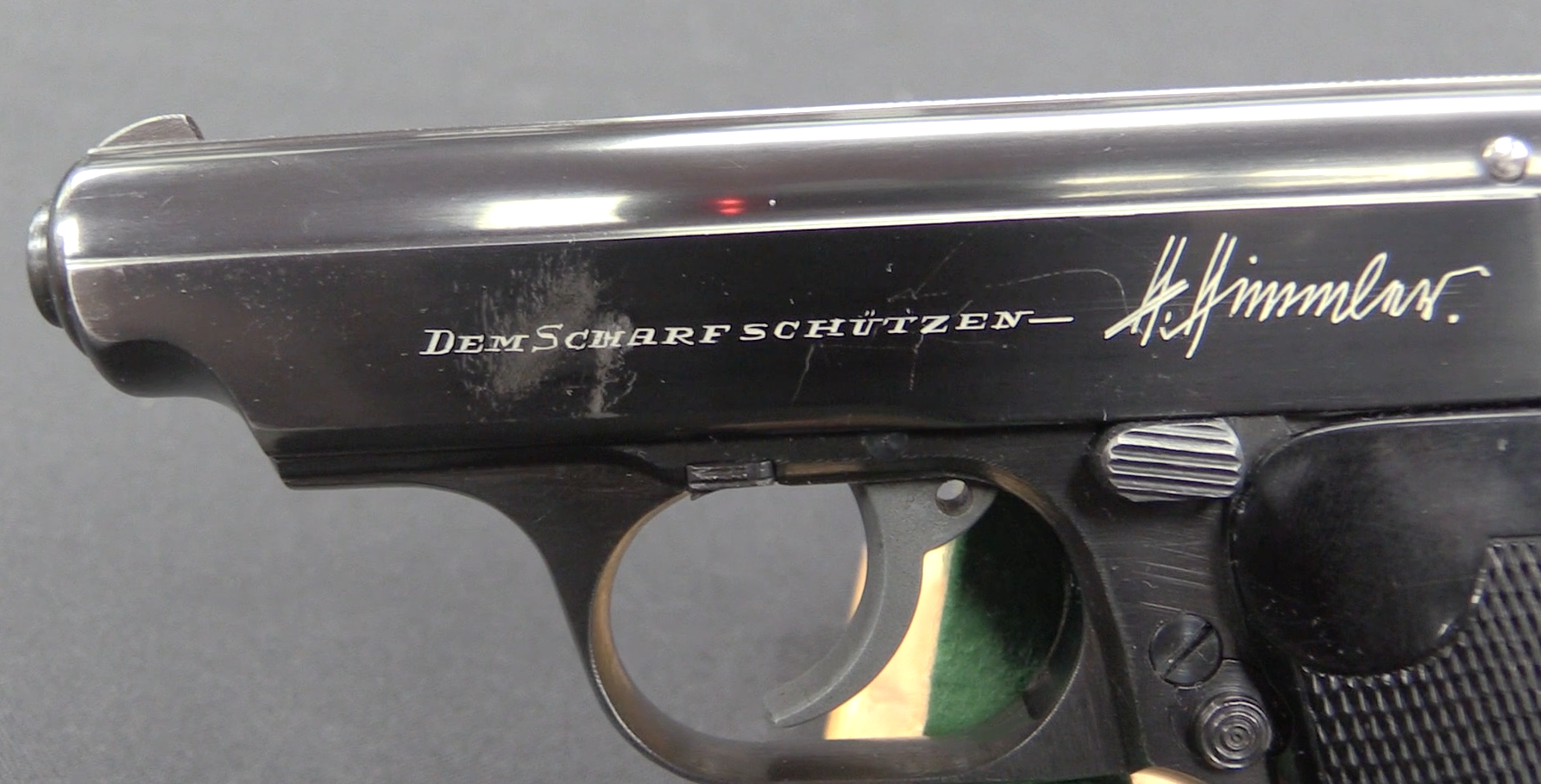
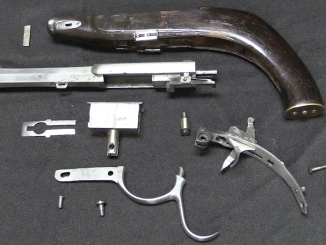
It suits his rather dapper appearance though doesn’t it, it’s a somewhat nonchalant stance.
I’ve seen old photos of cowboys holding the gun with elbow crooked and the revolver lazily hanging off the wrist close to the face. I think the old Bisley style “target” revolvers were intended to be held this way.
In sabre techniques, arm does not full-extend so much.
Considering those who received handguns were also sabre wielders, can we assume pistol stance is a part of a coherent fighting system?
(I mean using common moves or stances for various uses)
Most European handguns of that era were designed for either military use or police use, as even then there were restrictive laws regarding handguns in most of the countries over there. (Due to the anarchist movement- see The Dynamite Club by John Merriman.)
As such, designs reflected the usual military and police combat shooting stance, which was one-handed, in about a half-crouch, with the saber already drawn in the other hand. Yes, police carried swords, too; in fact, in Copenhagen, Denmark, the uniformed police were armed only with sabers until the mid-1960s.
Accuracy was a secondary consideration to speed. The officer was expected t be able to hit a charging assailant at ten yards or so, in the chest and head, with one or two shots in under a second.
This was based on colonial warfare and tactical doctrines. An officer’s job was to command, and manage the engagement; he was only to use his personal weapons in close-in self defense. The only exception to this was a cavalry charge, usually with sabers.
This ties in to the custom of carrying the pistol in a cross-draw belt holster. the theory there was to draw the saber first with the dominant hand (usually the right), and draw the pistol second with the “off” hand (generally the left).
There was also the cavalry influence. A trooper carried his pistol on the left side, cross-draw, to facilitate drawing it while mounted. Note that he was expected to use one hand to control the horse at all times. He would normally have the saber in the right hand, reins in the left. The pistol and carbine were considered secondary weapons to the saber. The pistol was often deployed in the left hand, along with the reins.
One trick was the “twist” draw with the left hand. Undo flap, turn wrist inward so back of hand faces ribcage, grasp pistol butt normally, draw straight up and swing forearm forward, then rotate hand on end of wrist to bring pistol upright. With practice, it can be done a lot faster than you’d think.
The arme blanche was still considered the primary weapon at that time. And the training and techniques of using the “secondary” weapon, the pistol, reflected this.
cheers
eon
“The pistol was often deployed in the left hand, along with the reins.”
Notice that French service Modele 1892 revolver cylinder swing-out to right promoting left-hand usage.
This is very likely also the reason the majority of solid-frame service revolvers of the era, notably the Colt M1873, German M1879/83, etc., have their loading gates on the right side of the frame. Hold revolver in left hand, load with right hand.
Granted, most (about 5 out of 6) people are right-handed, and you’d want to perform a fairly complex evolution like that with your “dextrous” hand, but still it’s consistent with the doctrine.
cheers
eon
Looking at the stance and at the sabre, that stance and grip would put him in a high guard position with the sabre, though he is in a much higher and more straight legged stance than he’d need for sword fighting.
I suppose one can picture a Japanese officer of the era with a saber or katana in his right hand and a Type 26 revolver in the other hand. See the posts about the Type 26 Nambu revolver…
The use of saber by infantry officers was just a function of weapons technology. The enlisted men and NCOs had their bayonets to use in close-quarters combat, but the officers’ pistol was of no use once it was empty. As you know, reloading a caplock pistol is quite slow, and while loading a cartridge revolver is noticeably faster, it still required relatively fine motor skills under the duress of combat. That was especially true for revolvers loaded through a loading gate, and even with a break-open or swing-out design I wouldn’t want to reload one cartridge at a time in combat.
So, the sabre was there to give the infantry officer an effective weapon in hand-to-hand combat, which was quite frequent and often the decisive phase of combat even in the mid-to-late 1800s. Only the introduction of repeating rifles, rapid fire breech loading artillery pieces and finally machine guns made it possible to break most infantry attacks farther away.
The use of swords in the cavalry is a somewhat different matter. Long before mid-19th century the main uses of cavalry had already become screening and pursuit. Decisive cavalry charges were not very common, although they still happened occasionally. Once repeating carbines become available, cavalry was often expected to fight dismounted and that role became increasingly important towards WW1. Some countries even had separate mounted infantry units, which were not properly trained for mounted combat (saving quite a lot of time and money from training both the men and the horses). Nevertheless, “real” cavalry retained the sabre (or lance) for charges and pursuit. What was the primary weapon was not very relevant; the sabre was the tradition, but in practice firearms were used more, and a good cavalry trooper was certainly expected to master them at least as well as the sabre.
This goes some way to help explain the fine, thin sights of handguns of 100 years ago – it never occurred to me simply that people tended to hold the gun closer to their face… (rushes off to pull out .455 S&W Hand Ejector to try it)
Did it work abacab? 🙂
A touch. But not a lot, since those sights are extremely fine anyway.
Smokeless powders were relatively new, as were auto-loading firearms.
I might have struck an odd shooting posture, had I been there in that time…
If you mentioned Roth M.7 notice that the later Austrian Steyr-Hahn pistol has grip angle near the right angle so using it with straight arm is less comfortable than folded. Same applies for Rast & Gasser 1898 revolver.
–
The one-hand shooting was considered default at least to WW2, for example ПОНОМАРЕВ in book titled РЕВОЛЬВЕР и ПИСТОЛЕТ – link: http://scilib.narod.ru/Military/Pistol/ – describes only one-hand handgun usage.
Also: take look on advert in this article: http://38super.net/Pages/History.html
Where the .38 Colt is described as a Ideal “One-hand-gun”
The grip spurs on my Roth Steyr and 1902 Mannlicher force the hand into that straight-up angle and one must bend the elbow to use the sights. The same goes for the pre-1911 Colt autos. For those of us trained in a two-handed shooting style, it seems a bit unnatural at first, but the current style of “combat” pistol shooting is a relatively new phenomenon. I am old enough to remember being taught one-handed revolver shooting and Fairbairn-style point shooting when I was a young lad by my grandfather, who was a WW1 Marine and a WW2 Seabee and had actually used his 1911 in real-live combat. I have also seen older (Indian Wars) cavalry holsters set up to use a right-handed reverse-draw with the Single Action Army and older cap-and-ball revolvers. I’ve tried it and it works pretty well.
It certainly does explain those steeper grip angles, which I had previously attributed to the mechanics of getting a straighter column of cartridges in a magazine housed in the grip.
although that is hardly a consideration with the Bergman and broom handle Mauser pistols.
It just struck me that the cocked elbow position is probably necessary to control a pistol on horseback – it probably gives you rather more control over the pistol than the modern straight arm target stance or very slightly bent IPSC-style stance if you’re on top of a beast that is moving at speed. The very bent elbow will let you compensate the movements of the horse when aiming.
I imagine that even after the horses went out, the style remained since it was what people knew, or what their instructors knew. Rather like the 1970s oblique push-pull Weaver stance refuses to die, even though it’s been completely succeeded at top-end competition level for 20+ years already
If slow accurate firing is what the designers had in mind with this pistol, why was the magazine so small? It seems to me an automatic pistol with only six shots doesn’t hold that much advantages, except maybe a lighter trigger pull, over a six shot revolver?
Quicker reload?
Considering the one-hand shooting stance. This was what I was taught (in the early 1960’s) in the equivalent of the American ROTC. For this reason, or some other , I did poorly – I did not reach the necessary minimum. (later, my ego was somehow recovered, when a professional told me, that what was at fault may have been the old TT pistols, which, as a result of long usage, would have very poor alignmnet, due to the Browning link. When my next try was a Polish derivate of the German PPK (with immovable barrel) my results were much better.
I think that (part, at least) of the explanation of the (conjectural) advantage of one-hand stance may be the tradition of duels which had become so famous (or notorious) during the 19th c.: when turned with your side to your enemy you offered to him much narrower target, and additionally, you could coud protect yourself with the pistol (especially if it was empty by that time).
Regards for all participants,
Andrzej